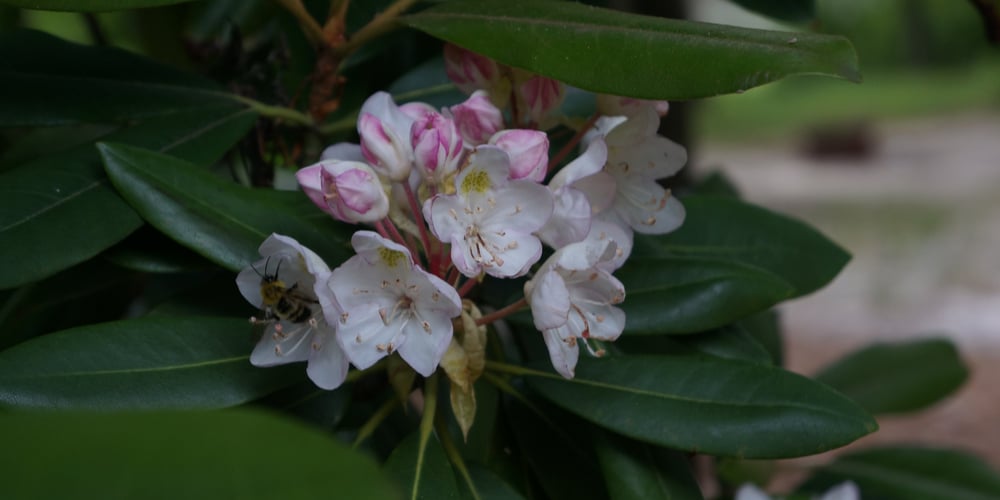The Indian Hawthorn is an evergreen and flowering shrub that doesn’t require a green thumb to grow.

| Botanical Name | Rhaphiolepis indica |
| Common Name | Indian Hawthorn, Hong Kong Hawthorn |
| Plant Type | Perennial |
| Flower Color | Pink and white clusters of blooms |
| Size When Mature | 36 to 72 inches |
| Bloom Time | Spring |
| Sun Requirements | Full sun, partial shade |
| USDA Hardiness Zones | 8 to 11 |
| Soil PH Range | 6.0 to 7.5 |
| Soil Type | Well-drained, acidic to slightly alkaline |
| Water Needs | Medium |
| Native Area | Taiwan and tropical Asia |
What you Need to Know About the Indian Hawthorn
Indian Hawthorns are low-growing, prolific shrubs that don’t need much to grow and thrive. In some regions, it’s considered an environmental weed, which speaks volumes about the plant’s survivability.
The evergreen shrub has a dense and mounded habit that works very well in foundation plantings, small gardens, and tight spaces. Although normally planted outside, some varieties can be potted and brought indoors as houseplants.
Growing the Indian Hawthorne is a matter of planting where you want it and letting nature do the rest. Small clusters of fragrant pink-white blooms appear as soon as early spring and are followed by small blue berries in summer.
How to Care for the Indian Hawthorn
Here’s everything you need to know about growing and caring for a thriving Indian Hawthorne
Light
To get the characteristic compact foliage and growth habit it’s recommended that you plant the Indian Hawthorn where it can get full sun every day. The shrub can tolerate partial shade or even a shaded area in your yard or garden at the expense of longer stems and leaves.
It’s worth noting that in order to get maximum blooms per growing season you should give your Indian Hawthorn enough light. Exposing the shrub to just a few hours of sun will give it a leggy appearance and very little color when spring comes.
Water and Soil Needs
The Indian Hawthorn isn’t too particular about soil pH. Most garden soil varieties will meet the shrub’s pH requirements just fine. A mix of garden or potting soil with organic matter such as compost works best for the plant. You can make the medium looser by adding perlite, pumice, or sand, which also helps make it drain water better.
What’s great about the Indian Hawthorn is that the species can tolerate salt quite well. You can also pot them up, but make sure the container has enough drain holes and that the soil doesn’t turn soggy or get waterlogged.
Watering should be done early morning or late afternoon, and more often in the first few months after planting in your yard. An established or mature Indian Hawthorn will be able to tolerate long periods of drought and a missed watering or two.
Temperature Requirements
The tropical evergreen shrub grows easily in zones 8 to 11, with some varieties able to grow in colder climates. However, most are sensitive to frost and will exhibit cold damage if left outside for too long.
Fertilizer
The best fertilizer to use on an Indian Hawthorne is a slow-release and balanced product given at the start of the growing season.
Generally speaking, the Indian Hawthorn is a light feeder and mainly relies on water and adequate light to thrive. However, you can supplement its growth in spring with a balanced fertilizer mix, particularly a slow-release type that will give the plant nitrogen, phosphorus, and potassium for several weeks.
You can also use a granular or liquid fertilizer at a half dose, or diluted at half-strength. Water the soil well after feeding so the nutrients can get to the roots.
Common Diseases
Indian Hawthorn plants are affected by entomosporium leaf spot, which is a fungal disease that spreads quickly if left unchecked. Small red spots will form on both the upper and lower part of the leaves, becoming bigger as time goes on. In severe infections, the plant will start to lose leaves.
Prevention is the first step to growing a healthy Indian Hawthorne. Space plants properly to promote good airflow, and avoid overhead irrigation as much as possible. Also, it’s recommended that you collect and dispose of diseased leaves in the cold season, and apply a layer of mulch to prevent weeds from growing around your plant.
Alternatively, planting your Indian Hawthorn where it can get full sunlight throughout the day can prevent leaf spot from occurring.
The Indian hawthorn does not require regular pruning other than removing dead leaves and stems. You can deadhead the flowers to encourage more buds to form right until the end of the spring season as well.
Indian Hawthorn Propagation
The Indian Hawthorne may be propagated from stem cuttings. Unlike other shrubs, the cuttings will have a higher chance of taking when you do it in fall and when the Indian Hawthorn is dormant.
Water your plant well the day before so it will be hydrated and healthy. In the morning, select healthy specimens and take stems that are about six to eight inches long. Prepare a small pot that has a well-draining and loose soil mix, then remove all the stem’s lower leaves. Stick the cutting into the medium and water them in well.
Place the pot and cuttings in a brightly lit but shaded spot, and in about four to six weeks it should have roots. Keep the soil slightly moist and transplant it to a new location.
Related Article: Trees That Start with H
